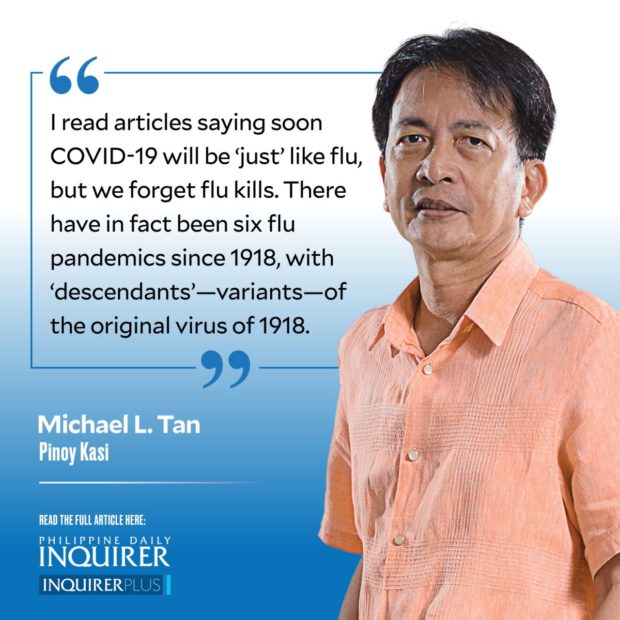Endemic: Not the end
It’s been two years since the COVID-19 pandemic and there’s a growing dangerous sense of complacency, spread in part by a word that’s taken on magical meanings: endemicity.
It doesn’t help that the word ends with, well, “end,” suggesting we’re seeing the end of this terrible scourge that has infected at least 435 million and killed 6 million worldwide.
Article continues after this advertisementThe word is actually derived from the Greek “en” and “demos,” which means an ominous “in the people,” i.e., when we say a disease is endemic, it means it is now established in the population and beyond that fact, we can’t really say with certainty what the future will be.
We try to whistle in the dark, especially by looking at the declining numbers of new infections and deaths and say, COVID is indeed in the human population but perhaps we can now live with it.
Many governments, including the Philippines, have in fact chosen this “live with COVID” approach rather than pursuing, as China does, a “zero COVID approach” that seeks to eradicate the virus completely, with often draconian measures like the lockdowns we’re seeing in Shanghai but even there, China has chosen not to be as drastic as with Wuhan in 2020, this time choosing localized lockdowns rather than the entire metropolitan Shanghai.
Article continues after this advertisementWhat I do worry about is that for countries like the Philippines, with still weak science and public health infrastructure, our complacency might allow the virus chronic resurgence, like typhoons or tsunamis, for many years to come, the code alerts becoming like typhoon signals.
When you look at the leading causes of death in the Philippines, you will find that we remain afflicted by endemic diseases that have long come under control, or even been totally eradicated, in many countries, not necessarily the rich ones.
Take dengue as an example of an endemic disease in the Philippines. The last peak we had with dengue was in 2019 with some 430,000 cases and 1,612 deaths.
COVID-19 erupted in 2020 and led to a decline in dengue—“only” 231 deaths in 2020 and 285 in 2021. Can we live with only “285” deaths?
We had some 16,000 deaths from highly infectious respiratory tuberculosis in 2021, not acceptable by any international public health standard and yet the disease is rarely seen as a problem.
In 2020, the first year of the COVID pandemic, the Philippine Statistics Authority reported 27,967 deaths from COVID, making it the seventh leading cause of death in the country. In 2021, this rose to 105,723 deaths, making it the second leading cause of death. With vaccinations, and less virulent variants, we are sure to see a decrease in both infections and deaths this year, but will there ever be a number we can accept as tolerable?
I read articles saying soon COVID-19 will be “just” like flu, but we forget flu kills. There have in fact been six flu pandemics since 1918, with “descendants” — variants — of the original virus of 1918.
What will happen with COVID-19?
It depends on whether the world, and the Philippines, is ready to learn from the current pandemic. The medical scientists now beginning to write and speak out on the dangers of complacency have common recommendations:
First, surveillance needs to continue, which means testing, especially for vulnerable populations like the elderly.
Second, systems need to be in place to mobilize people to take action right away, especially at the level of communities. Inevitably, the poor will be most adversely affected again, given crowded living conditions.
Third, protective behaviors need to continue, from using masks to vaccinations and, most importantly but most neglected, coming up with new standards for indoor ventilation in all buildings.
More on biomedical protective behaviors, it also means social protection measures so when we have new outbreaks and, god forbid, pandemics, we can mitigate the terrible economic and social harm.
More importantly, bearing in mind our personal losses and grief last year due to the Delta surge — I recently talked with a UP dean whose college lost four professors — can we afford to shrug our shoulders and go back to the old abnormal times that allowed COVID-19 to be so destructive?
















